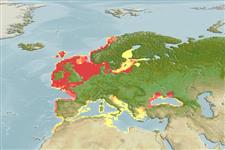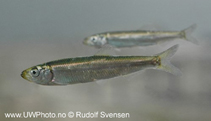Masukkan pemerhatian anda di Fish Watcher
| Native range | All suitable habitat | Point map | Year 2050 |

|
| This map was computer-generated and has not yet been reviewed. |
| Sprattus sprattus AquaMaps Data sources: GBIF OBIS |
muatnaik fotos/gambar dan video
Pictures | imej GoogleSprattus sprattus
Picture by Svensen, R.
Pictures | imej GoogleSprattus sprattus
Picture by Svensen, R.
Georgia country information
Common names:
[No common name]
Occurrence: native
Salinity: brackish
Abundance: | Ref:
Importance: minor commercial | Ref: FAO, 1994
Aquaculture: | Ref:
Regulations: | Ref:
Uses: no uses
Comments: Also Ref. 188.
National Checklist:
Country Information: https://www.cia.gov/library/publications/resources/the-world-factbook/geos/gg.html
National Fisheries Authority:
Occurrences: Occurrences Point map
Main Ref: Ninua, N.Sh. and B.O. Japoshvili, 2008
National Database:
Occurrence: native
Salinity: brackish
Abundance: | Ref:
Importance: minor commercial | Ref: FAO, 1994
Aquaculture: | Ref:
Regulations: | Ref:
Uses: no uses
Comments: Also Ref. 188.
National Checklist:
Country Information: https://www.cia.gov/library/publications/resources/the-world-factbook/geos/gg.html
National Fisheries Authority:
Occurrences: Occurrences Point map
Main Ref: Ninua, N.Sh. and B.O. Japoshvili, 2008
National Database:
Common names from other countries
klasifikasi / Names Nama-nama umum | Sinonim (persamaan) | Catalog of Fishes(Marga, Jenis) | ITIS | CoL | WoRMS | Cloffa
> Clupeiformes (Herrings) > Clupeidae (Herrings, shads, sardines, menhadens)
Etymology: Sprattus: Old German, sprotte (1611) = a small fish, Clupea sp. (Ref. 45335).
More on author: Linnaeus.
Etymology: Sprattus: Old German, sprotte (1611) = a small fish, Clupea sp. (Ref. 45335).
More on author: Linnaeus.
Issue
The subspecies were not characterized well enough, that unless there is more evidence presented in the future, Sprattus sprattus should be considered as one species with several known populations (S.Kullander, pers.comm. 07/09).
Environment: milieu / climate zone / depth range / distribution range Ekologi
laut; payau; oceanodromus (Ref. 51243); kisaran kedalaman 10 - 150 m (Ref. 6302). Temperate; 69°N - 30°N, 11°W - 42°E
Penyebaran Negara-negara | Daerah-daerah FAO | Ecosystems | Kemunculan | Point map | Introduksi | Faunafri
Northeast Atlantic: North Sea and adjacent waters as far north as the Lofoten Area and the west of the British Isles, and Baltic Sea south to Morocco; also in northern Mediterranean (Gulf of Lion and the Adriatic Sea) and Black Sea.
Length at first maturity / Size / Weight / umur
Maturity: Lm 10.1, range 8 - 12 cm
Max length : 16.0 cm SL jantan/; (Ref. 188); common length : 12.0 cm SL jantan/; (Ref. 188); Umur maksimum dilaporkan: 6 Tahun (Ref. 3561)
Max length : 16.0 cm SL jantan/; (Ref. 188); common length : 12.0 cm SL jantan/; (Ref. 188); Umur maksimum dilaporkan: 6 Tahun (Ref. 3561)
deskripsi pendek Kunci identifiaksi (pengenalan) | Morfologi | Morfometrik
Duri punggung (Keseluruhan (total)) : 0; duri punggung lunak (Keseluruhan (total)) : 13 - 21; Duri dubur: 0; Sirip dubur lunak: 12 - 23. Lower jaw slightly projecting, gill cover without any bony radiating striae, teeth rarely present on vomer; belly with a strong keel of scutes; last two anal fin rays not enlarged. No dark spots on flanks. Pterotic bulla absent.
Usually inshore schooling, sometimes entering estuaries (especially the juveniles) and tolerating salinities as low as 4 ppt. Shows strong migrations between winter feeding and summer spawning grounds. Moves to the surface at night. Feeds on planktonic crustaceans (Ref. 9900). Spawns at depths of 10-20 m producing 6,000-14,000 pelagic eggs (Ref. 35388). Some spawn almost throughout the year, mainly in spring and summer, near the coast or up to 100 km out to sea, the young drifting inshore. Sold as 'brislings' to canneries. Sprat are used in the production of fish meal and as mink food, less for human consumption (Ref. 9900). Utilized fresh, smoked, canned and frozen; can be pan-fried and broiled (Ref. 9988).
Life cycle and mating behavior Kematangan | Reproduksi, perkembang biakan | Pemijahan | telur-telur | Fecundity | Larva
Some spawn almost year round but mainly in spring and summer, near to the coast or up to 100 km out to sea, the young drifting inshore. Individual period of spawning takes about two months (Ref. 92054).
rujukan utama
Upload your references | Acuan | Koordinator | mitra
Whitehead, P.J.P., 1985. FAO Species Catalogue. Vol. 7. Clupeoid fishes of the world (suborder Clupeoidei). An annotated and illustrated catalogue of the herrings, sardines, pilchards, sprats, shads, anchovies and wolf-herrings. FAO Fish. Synop. 125(7/1):1-303. Rome: FAO. (Ref. 188)
Status IUCN Red List (Ref. 130435: Version 2024-2)
kurang bimbang (LC) ; Date assessed: 18 July 2018
penggunaan manusia
Perikanan: bernilai komersial tinggi; umpan: usually
FAO(Perikanan: production, profail spesis; publication : search) | FIRMS (Stock assessments) | FishSource | Sea Around Us
informasi lanjut
Life cycle
Reproduksi, perkembang biakan
Kematangan
Fecundity
Pemijahan
Spawning aggregations
telur-telur
pekembangan telor
Larva
Dinamika larva
Reproduksi, perkembang biakan
Kematangan
Fecundity
Pemijahan
Spawning aggregations
telur-telur
pekembangan telor
Larva
Dinamika larva
Physiology
Body composition
Nutrients
Oxygen consumption
Swimming type
Swimming speed
Visual pigments
Fish sound
Diseases & Parasites
Toxicity (LC50s)
Body composition
Nutrients
Oxygen consumption
Swimming type
Swimming speed
Visual pigments
Fish sound
Diseases & Parasites
Toxicity (LC50s)
Genetics
Genetika
Heterozygosity
Diturunkan
Genetika
Heterozygosity
Diturunkan
Alat, peralatan
Bio-Quiz | E-book | Penuntun lapangan | Kunci identifiaksi (pengenalan) | tanda freqkuenci panjang | peringkat sejarah hidup | peta titik | Classification Tree
| Catch-MSY |
laporan khas
muat turun XML
Sumber internet
Alien/Invasive Species database | Aquatic Commons | BHL | Cloffa | BOLDSystems | Websites from users | semak peneliti ikan | CISTI | Catalog of Fishes(Marga, Jenis) | DiscoverLife | ECOTOX | Faunafri | Fishtrace | GenBank(genom, Nukleotida) | GloBI | GOBASE | | Google Books | Google Scholar | Google | IGFA World Record | MitoFish | Pangkalan data nasional | Otolith Atlas of Taiwan Fishes | PubMed | Reef Life Survey | Scirus | SeaLifeBase | Tree of Life | Wikipedia(pergi, Cari) | World Records Freshwater Fishing | Zoological Record
Estimates based on models
Preferred temperature (Ref. 115969): 4.3 - 15.3, mean 9.5 (based on 530 cells).
Phylogenetic diversity index (Ref. 82804): PD50 = 0.5312 [Uniqueness, from 0.5 = low to 2.0 = high].
Bayesian length-weight: a=0.00550 (0.00468 - 0.00646), b=3.10 (3.05 - 3.15), in cm Total Length, based on LWR estimates for this species (Ref. 93245).
Trophic level (Ref. 69278): 3.0 ±0.07 se; based on food items.
Daya lenting (Ref. 120179): sedang, Waktu penggandaan populasi minimum 1.4 - 4.4 tahun (rm=1.7; K=0.14-0.77; tm=1-2; tmax=6; Fec=2,000 (batch fec)).
Prior r = 0.48, 95% CL = 0.32 - 0.72, Based on 17 full stock assessments.
Fishing Vulnerability (Ref. 59153): Low vulnerability (25 of 100).
Climate Vulnerability (Ref. 125649): Low vulnerability (15 of 100).




